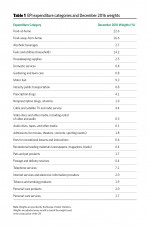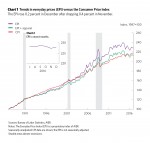Consumer Demand Fuels Entertainment Price Hikes
AIER’s monthly Everyday Price Index inched up 0.2 percent in December, led by rising gasoline prices. The EPI measures price changes that people see in everyday purchases such as groceries, gasoline, utilities, and personal-care products. Over the past 12 months the EPI has climbed 1.5 percent.
The EPI including apparel, a broader measure, dropped 0.1 percent on a 0.3 percent fall in clothing prices. Over the past 12 months, the broader index rose 1.4 percent. Both indexes exclude prices of infrequently purchased, big-ticket items (such as cars, appliances, and furniture) and prices that are contractually fixed for prolonged periods (like housing).
The more widely known price gauge, the Consumer Price Index reported by the U.S. Bureau of Labor Statistics, was unchanged for the month on a seasonally unadjusted basis and moved 2.1 percent higher over the past 12 months. The EPI is not seasonally adjusted, so we compare it with the unadjusted CPI.
Prices for tickets to movies, theaters, and concerts rose 0.4 percent in December. Over the past year, admissions have increased 1.9 percent. Prices for home entertainment were also higher. Cable and satellite television and radio service prices rose 0.2 percent for the month and are up 4.7 percent over the past year. Fees for group exercise and lessons increased 0.3 percent in December while prices for recreational reading material jumped 1.4 percent.
Solid consumer demand has supported the price increases for entertainment and leisure, and demand, in turn, has been fed by job growth. Real consumer spending on recreation has climbed 6.1 percent over the past 12 months, faster than its long-term average of 4.2 percent. Over the past year, nonfarm payroll growth has averaged 180,000 per month. The unemployment rate is 4.7 percent, near a post-recession low. A broader measure of unemployment, which includes part-time workers who want full-time work, is at a post-recession low of 9.2 percent. More job openings suggest that hiring will continue in the coming months.
Rounding out the EPI, gasoline prices were 1.8 percent higher in December. Gas prices have jumped 9.2 percent over the past year, reflecting lower domestic production of crude oil. In December 2016, domestic crude oil production was 8.9 million barrels a day, down from 9.2 million barrels a day a year earlier.






